Student Profile: James Hulderman14 min read
This dentist will be both Dr. Hulderman and Chef James
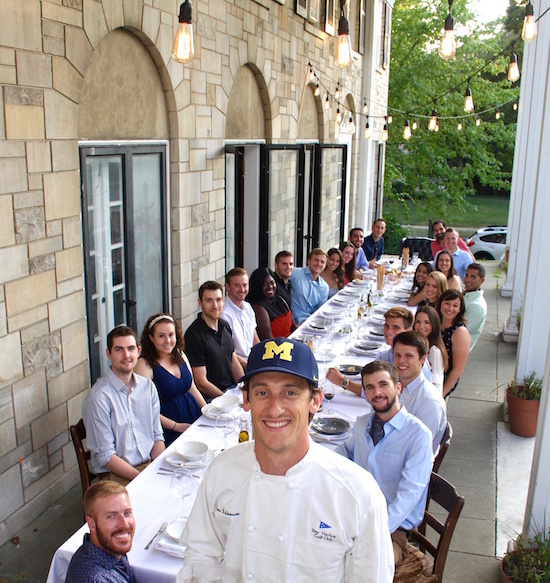
One in a series of profiles of School of Dentistry alumni, donors and students.
Ann Arbor, Mich., Dec. 18, 2018 — Fourth-year dental student James Hulderman is asked the question frequently. With just a semester left until he graduates from one of the top dental schools in the country, classmates and friends want to know: “So are you going to be a dentist or a chef?”
The question often comes at the multi-course dinner parties he hosts at the Delta Sigma Delta dental fraternity, or at the larger dental school receptions he caters for faculty and students. Sometimes it comes up during conversations among classmates, when he describes how the dental school staples of organic chemistry and biochemistry relate closely to the science of cooking. Or maybe people are curious about his future when he shares details like the fact that he never wanted to live in a fraternity house until he saw the kitchen at the Delta Sig house. Revelations like that are why he has become known over the last four years at the dental school as “Chef James.”
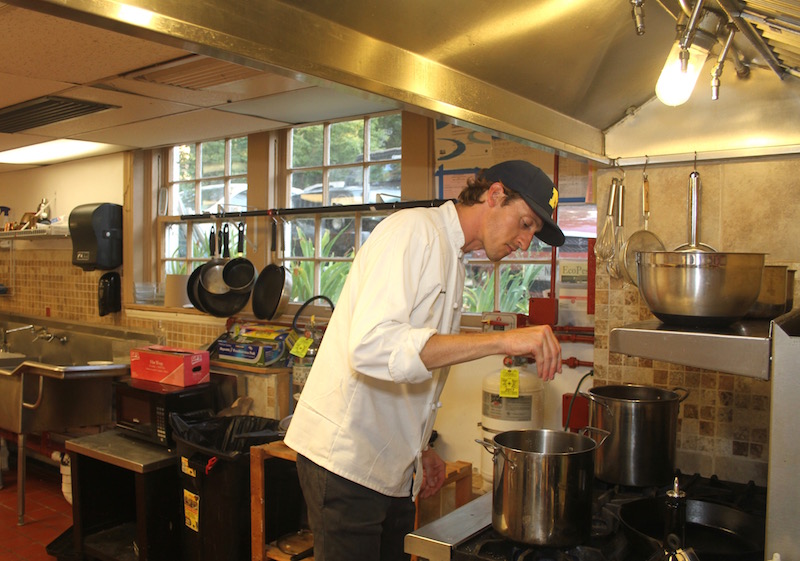
James seasons one of his culinary creations as he cooks in the fraternity’s basement-level kitchen. 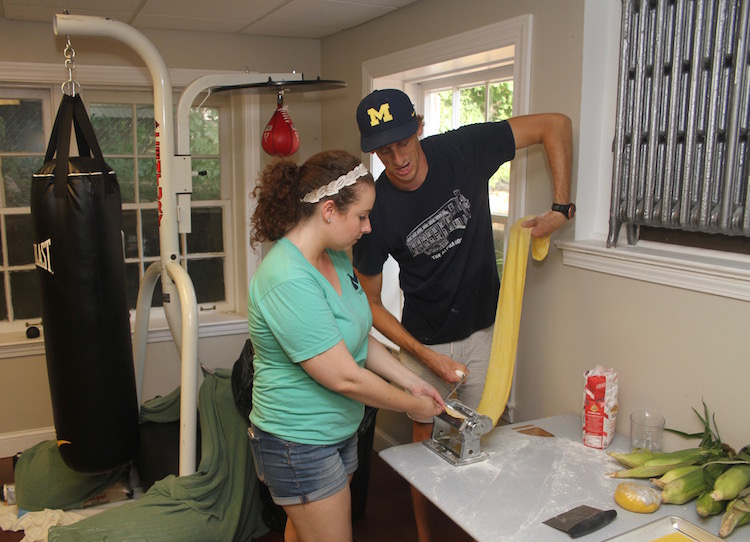
The fraternity’s punching bags serve as a backdrop as Rachael Vernon helps James roll out pasta in an adjacent room. 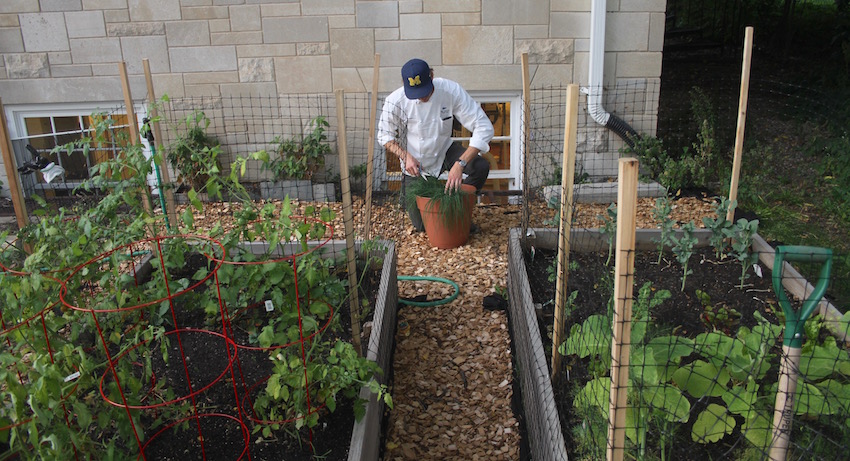
James gathers herbs in the garden just outside the fraternity kitchen. 
Fellow D4 and cooking assistant Jimmy Young gets a laugh as James tastes one of his tastings at stove-side. 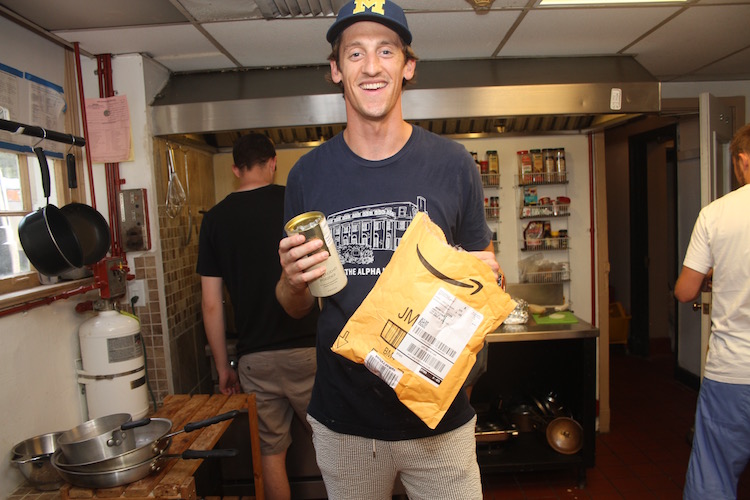
Early in the preparation for one of his dinners, James discovers that an ingredient he ordered online — soy lecithin powder, a natural emulsifier — has arrived just in time. 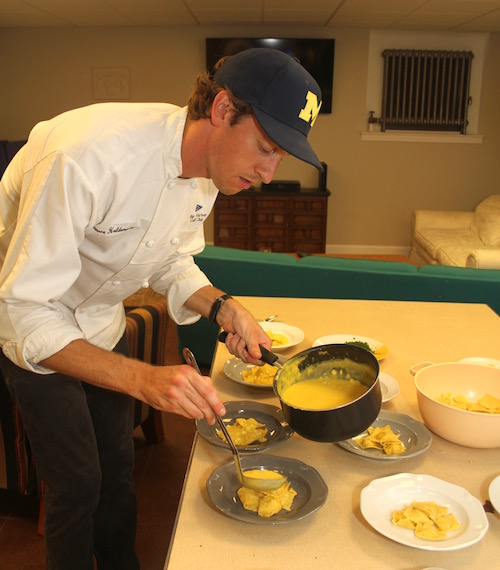
James spoons out the sauce for his White Corn Agnolotti with Chanterelle during the plating process. 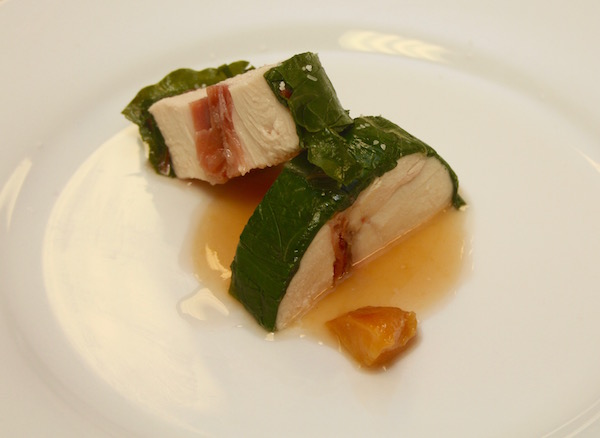
James’ version of Swiss Chard Rouelle of Poularde and Prosciutto. 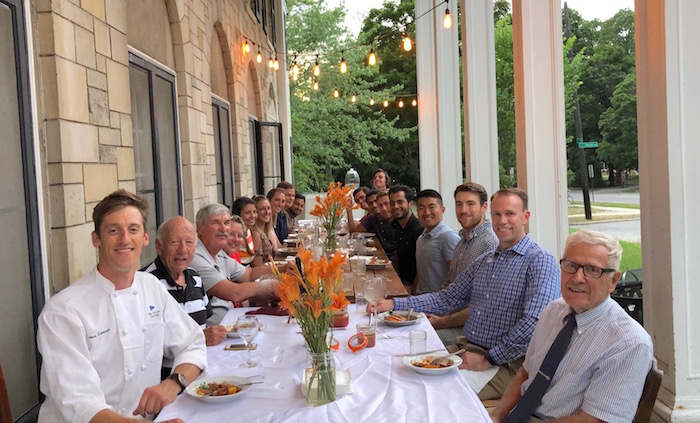
Faculty and students joined James (left) for this summer 2018 dinner. 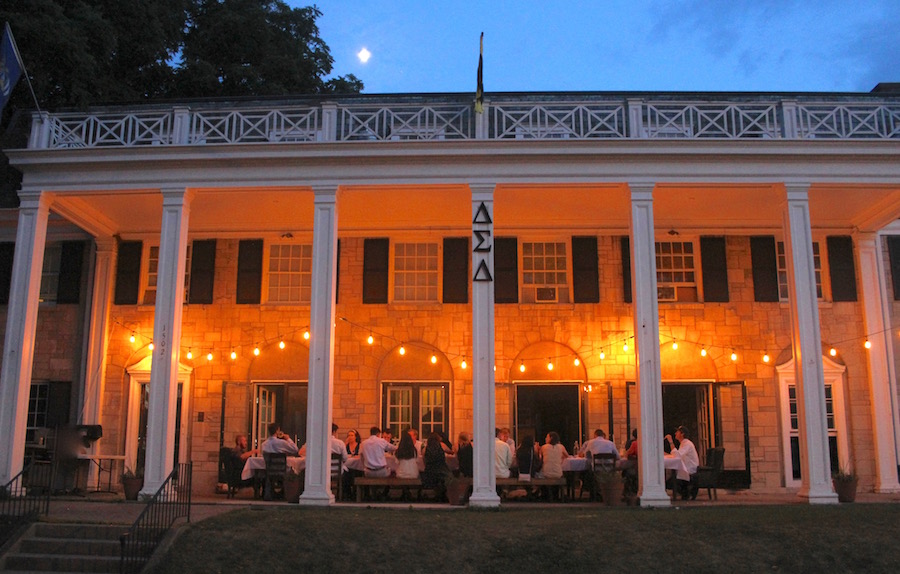
As dusk sets in, the moon rises over the Delta Sig house as James (far right) sits down with his guests on the veranda.
That moniker doesn’t quite capture the sophistication of Hulderman’s passion for preparing food. A better way to explain his interest in food may be to drop the names of a couple of the three-star Michelin-rated restaurants where he has eaten. Those are the highest-rated restaurants in the world — the kind where a two-person seating, as they are called in the business, starts at somewhere around $1,000 and you have to make the reservation months in advance.
A couple of years ago, he planned a trip to the Napa Valley in California, not for the wine, like most people. Instead, he went so that he could dine at The French Laundry, a legendary restaurant that has been rated at various times as not just one of the world’s finest restaurants, but THE finest restaurant in the world. And then there’s his evening at Alinea in Chicago, owned by a chef who trained at The French Laundry and who is regularly in the discussion of best in the world. Hulderman also scored a one-star Michelin restaurant a year ago in Italy and a two-star more recently in Sweden, both on trips with his girlfriend and her parents, who are not only fellow foodies but also dentists.
Hulderman doesn’t enter the rarefied air of these restaurants merely to enjoy a world-class meal. He views his dinner dates there as education — a way to learn about food preparation and presentation, with the idea of advancing his ability to do the same. He already has the cookbooks from many highly rated restaurants and chefs, but at some point it’s important to stimulate the senses in person. Tasting is believing.
Hulderman’s ongoing journey toward self-taught connoisseur of fine dining had a slow and unlikely start in his small hometown of Alanson, Mich., near Petoskey. After undergoing dental work as a child, he knew by high school that he wanted to be a dentist. His interest in food came later, in subtle ways. Growing up in what he says was a blue-collar family — his dad is a carpenter and his mom a nurse — he and his sister were part of a rotation with each family member cooking on a different night. Food also played a role in his neighborhood, which had frequent potluck gatherings where his neighbors were somewhat competitive about bringing the best entrees, which resulted in a lot of great food to sample. The first non-family dinners he organized were during his high school years, when he and friends hosted small dinners for his school’s steady stream of foreign exchange students, creating dishes from their home countries as a way to welcome them.
The next big step in his food interest was prompted, strangely, by an accident one day in the driveway of his home. He pulled a family car into the driveway a bit too fast and crashed into the garage door, damaging his dad’s Corvette that was parked inside. Dad was none too pleased and told James he needed to immediately get a job to earn some money for the repairs. A friend who worked at the nearby Douglas Lake Bar, a popular restaurant in Pellston, helped James get a job there. It couldn’t have been a better introduction for a high school student with a growing interest in food. Not only did the restaurant make all its food from scratch, but Hulderman somehow bypassed the usual starting position as a dishwasher and went immediately to making salads, desserts and bread. “I didn’t even know how to cut an onion,” he recalls. “The chef was shaking his head, ‘Where did we get this guy from?’” But Hulderman made up for his lack of experience by observing and asking lots of questions. After two summers there, he moved on to other restaurants over the next few years, including the famed Bay Harbor Golf Club and the Twisted Olive, an upscale restaurant with Mediterranean cuisine in Petoskey.
The next big impact on Hulderman’s interest in food was a book his father heard about and recommended during James’ undergraduate days at Northern Michigan University. “Life, on the Line” is the story of chef Grant Achatz, co-owner of Alinea, the world-class Chicago restaurant that Hulderman would eventually experience. Included with Achatz’s chef history is the story of how he also battled oral cancer into remission, a topic apropos for a soon-to-be dental student. Hulderman was fascinated. He began tracking down book after book on world-class chefs, restaurants and cuisine. It inspired him to prepare more sophisticated food and to immerse himself in the culture of high-end dining. By the time he was accepted into the U-M dental school, he was sharing his food interest on a wider scale, through social media among other ways.
Rachael Vernon, another Class of 2019 student, recalls seeing Hulderman’s food photos as the class members first began corresponding in the spring before they arrived at the school. She is a foodie, though not at his level. “He had the craziest pictures of this amazing food,” she said. “I like to cook, but I like more approachable cooking, and he’s just doing this crazy stuff. I would comment on his photos because I was so impressed with it. And he said, well, I need a sous chef when we get there.” So Vernon volunteered be his assistant when he moved into the Delta Sig house and began hosting food events. They were small at first, then morphed into elegant dinners for around 20 people. In the summertime, they were held on the veranda at the front of the striking stone fraternity. Vernon’s finance, Jimmy Young, also a member of the class, became another of Hulderman’s assistants when the complexity of the dinners increased.
Hulderman credits Dr. Dan Edwards, an adjunct faculty member at the dental school and advisor to Delta Sigma, for the quality of the kitchen at the house and agreeing to further improvements requested by the talented new D1 chef who had joined the fraternity. Edwards also approved the cost of creating a small garden out back so that Hulderman would have easy access to fresh ingredients.
At first, Hulderman didn’t charge the friends and classmates he invited to dinner. Vernon, among others who attended the events, was incredulous that he would absorb the expense. They offered to pay for the privilege of his fine dining, and he eventually relented, establishing a contribution that ranges from $12-18 for meals that can cost much more than that. “He never breaks even,” Vernon offers. Hulderman shrugs and says he’s learning so he can’t very well charge a high-end fee even though he prepares several courses, or tastings. The money allows him to work with more expensive ingredients that he otherwise couldn’t afford, like fresh black truffles, foie gras, Ossetra caviar and oysters.
The menu at one of his dinners in the last year looked like this:
“Aperitivi”
Aperol Spritz
“Antipasti””
Rosemary Focaccia, Prosciutto, Fontina, Bella di Cerignola
“Primi Piatti”
1st — Porchini Risotto
2nd – White Corn Agnolotti with Chanterelle
“Secondi Piatti”
1st — Swiss Chard Rouelle of Poularde and Prosciutto
2nd — Gnocchi Mint Marinated Courgettes and Fresh Tomato Sauce
“Dolci”
Fig Galette and Gelato
While Hulderman labored over a gas stove in the basement kitchen of the DSD house for most of the food on this menu, it also allowed him to engage his longstanding interest in science by using a cooking method called Sous-vide, a French expression meaning “under vacuum.” The Rouelle of Poularde on his menu was a chicken breast wrapped around prosciutto, then wrapped in swiss chard. The combination was wrapped tightly in plastic wrap, then placed in a plastic bag submerged in a water bath in an appliance that closely keeps the water temperature consistent for several hours. Hulderman can walk away and work on other parts of the dinner while the chicken cooks at a much lower temperature than an oven or stovetop would require. It allows the inside of the food to be cooked properly without overcooking the outside of the food. It’s a method that falls into a modern style of cooking called molecular gastronomy, which relies on the physical and chemical transformation of ingredients during cooking, sometimes using natural enzymes and often taking advantage of new appliances developed specifically for these new methods of cooking.
As the food for each tasting was completed, Hulderman plated it with help from his assistants, then shuttled the plates upstairs to the veranda. With each course, he stood at the head of the table and introduced the food and told how it was created, a little of its history where applicable, then sat with his guests as they started the course. Soon it was back to the kitchen where he and his crew finished the next course and washed dishes because his many courses take more plates than the fraternity has in its collection. By the end of the evening, he was spent physically and mentally. As with most of his culinary evenings, he was generally happy with the way the dinner turned out, but he notes that fine restaurants have several chefs creating and plating the food, not just one guy and a couple of assistants. If he were creating food and presentation for only two or four people, he would insist on absolute perfection; creating 20 plates basically by himself requires compromises, he says.
“It’s a high-stress, demanding job,” he said. “The lifestyle of a chef is just go, go, go. I learned that early on. I knew I didn’t want to pursue that as a profession. I always felt that if you make your hobbies a career, they are no longer hobbies. I probably would have fallen out of love with it.”
He compares cooking to participating in triathlons, another of his hobbies. While he is swimming, biking and running, it is not enjoyable and he swears to himself during the event that he will never enter another one. But then at the end, when he feels the satisfaction and tired pleasure of accomplishing a major feat, he’s ready to do it next time. Preparing a multi-course meal is the same feeling — not necessarily fun during the stress of creating it, but a major sense of accomplishment watching a table full of people enjoy his creations. “With the plates I put out, I try to stimulate all the senses. If something can be visually appealing, taste good, smell good, maybe it has a textural component that you can feel — if I can stimulate all those senses and you are surrounded by great people who you are talking to, that’s a great feeling.”
Food creates friends. “That was something I felt really fortunate about when I started dental school,” he said. “There were just so many people from all around the world that I was now classmates with. And I was the food guy. So what better way to get people together and just see what conversations spark. … I’ve been very fortunate to pick up this kind of skill. And fortunate that there are friends out there, people out there, who appreciate it and want to come to these parties.”
He remains committed to beginning his career as a general practice dentist after he graduates next May. But he will continue his small dinner groups and consider a part-time catering business on the side. “I want to keep my hand in it to keep my skills sharp, which is the same thing you need to do with dentistry or any skill,” he said.
Dentistry and cooking are a good mix because they combine his interests of science and art. “With cooking it’s a little more of an art. You can adlib and add your own flair to it, which I really like. And it’s something we have to do to stay alive. It’s a good passion, a good hobby.”
###
The University of Michigan School of Dentistry is one of the nation’s leading dental schools engaged in oral health care education, research, patient care and community service. General dental care clinics and specialty clinics providing advanced treatment enable the school to offer dental services and programs to patients throughout Michigan. Classroom and clinic instruction prepare future dentists, dental specialists, and dental hygienists for practice in private offices, hospitals, academia and public agencies. Research seeks to discover and apply new knowledge that can help patients worldwide. For more information about the School of Dentistry, visit us on the Web at: www.dent.umich.edu. Contact: Lynn Monson, associate director of communications, at [email protected], or (734) 615-1971.
